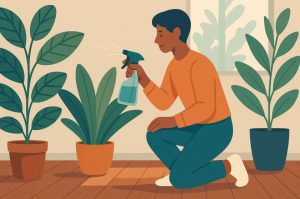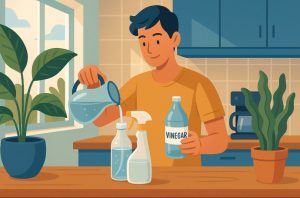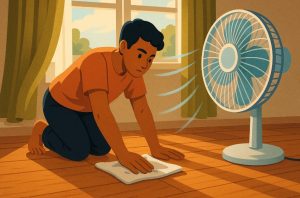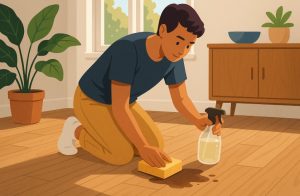Have you ever wondered if there’s a safer and more effective way to clean your wooden floors without relying on harsh chemicals? Maintaining the natural elegance of your hardwood flooring doesn’t have to come at the cost of its durability or your indoor air quality. Natural cleaning methods not only preserve the beauty of the wood but also support a healthier environment in your home.
Whether you’re dealing with muddy footprints, accidental spills, or daily dust buildup, there are natural, non-toxic ways to get the job done right. With the right techniques, tools and ingredients, you can achieve clean and polished wooden floors without risking discolouration, warping, or damage.
In this guide, you’ll discover simple, affordable, and eco-conscious methods for cleaning wooden floors naturally at home. Let’s explore how to give your wooden floors the care they deserve, while keeping your living space safe and sustainable.
Why Should You Use Natural Methods to Clean Wooden Floors?

Using natural methods to clean wooden floors offers several compelling benefits, especially for households in the UK looking for eco-friendly and long-lasting floor care.
First and foremost, natural solutions are gentle on wood surfaces. Commercial cleaners often contain harsh chemicals that can degrade wood over time, causing discolouration, dullness, or even cracking in certain finishes.
Natural ingredients like white vinegar, mild dish soap, and essential oils clean effectively without compromising the integrity of your flooring.
In addition to protecting your floors, natural cleaning methods are healthier for you and your family. Chemical residues left behind by synthetic products can affect indoor air quality and pose risks for children or pets who regularly play on the floor. Natural products, on the other hand, offer a non-toxic alternative.
Furthermore, natural cleaners are cost-effective and readily available. You can make your own cleaning solutions using household staples, cutting down on unnecessary expenses. Plus, you’ll reduce plastic waste and reliance on single-use products.
When you clean wooden floors naturally, you’re not just removing dirt. You’re making a conscious choice to preserve your home’s charm and safeguard your family’s well-being.
What Should You Do Before Cleaning Wooden Floors?
Before applying any cleaning solution to your wooden floors, it’s crucial to prepare the area properly. This ensures you don’t inadvertently cause scratches or damage while cleaning.
Start by clearing the area of furniture or obstructions, giving yourself enough space to move freely and access all floor sections. Use felt pads when shifting furniture to avoid marking the surface.
Inspect the floor surface for loose debris or dirt. Grit and dust can act as abrasives, scratching the wood as you mop. Regular dry cleaning is essential.
- Use a soft-bristled broom or a microfibre dust mop to gently remove dust, hair, and dirt.
- Alternatively, vacuum with a hard floor attachment to ensure no debris remains.
- Avoid vacuums with rotating brushes as they may scuff the surface.
Once your floor is dust-free, ensure there are no lingering sticky spots or residue from past spills. Use a slightly damp cloth to pre-treat any sticky areas before general mopping.
Lastly, check the finish of your floor. Different finishes respond differently to moisture. If unsure, test any solution in a small, hidden section before applying it across the floor. Proper preparation not only makes the cleaning more effective but also helps maintain your wooden floor’s condition and appearance for the long term.
Step-by-Step Guide: How to Clean Wooden Floors Naturally?
Cleaning wooden floors naturally is both an effective and sustainable way to preserve their timeless look. Follow this step-by-step method to ensure your floors are cleaned thoroughly without damage.
Step 1: Remove Dust and Debris Gently

Begin by clearing away all loose dirt and debris. Use a soft-bristle broom or a dry microfibre mop to sweep the surface. This removes dust particles that might scratch the wood during mopping.
If you prefer vacuuming, select a vacuum designed for hardwood floors or one with a soft floor setting. Ensure there are no rotating brushes in contact with the surface to prevent scratches.
Avoid steam cleaners or wet vacuums, which introduce too much moisture. The goal at this stage is dry, gentle cleaning that lifts debris without harming the wood.
Step 2: Mix a Natural Cleaning Solution

Now, prepare your natural cleaner.
You can choose from a few safe, effective options:
- Vinegar and water: Mix 1 part white vinegar with 3 parts warm water. Add 10 drops of essential oil for fragrance.
- Dish soap and water: Mix a few drops of mild, eco-friendly dish soap with a bucket of warm water.
- Olive oil mix: Add 1 tablespoon olive oil to a litre of water with a small amount of natural soap for shine.
Always test your chosen mix on a small patch first, especially if your floor has a wax or oil finish.
Step 3: Mop Using the Right Method

Dip a microfibre mop into your cleaning solution, then wring it out thoroughly. The mop should be damp, not wet, to avoid saturating the wood. Begin mopping in the direction of the wood grain. This helps avoid streaks and ensures an even clean.
Clean small sections at a time, rewetting and wringing out your mop as needed. Spray bottles can also be used to mist the solution directly onto the floor before wiping with a dry mop.
Step 4: Dry the Floor Properly

After mopping, never leave the floor damp. Use a clean, dry cloth or dry microfibre pad to blot any remaining moisture. This is especially important in corners and edges where water may pool. To speed up drying, open windows or switch on a fan. Air drying is safe as long as water is not left standing.
Step 5: Deal with Stains and Scuff Marks Naturally

For stains, use a soft cloth and baking soda paste. Gently rub the area, then wipe clean. For scuff marks, try rubbing with a tennis ball or sock. Stubborn spots can be treated with a vinegar-water solution or natural soap.
Always avoid bleach, ammonia, or abrasive scrubbers that can strip the wood’s finish. This natural cleaning routine, when followed regularly, will help you keep your wooden floors looking fresh and polished year-round.
What Natural Cleaners Are Safe for Wooden Floors?
Not all natural products are safe for hardwood, but several gentle ingredients work exceptionally well. Choosing the right cleaner protects the wood’s finish while effectively lifting dirt and grime.
- Vinegar and Water: A diluted white vinegar mix is a popular option. When mixed correctly with water, it helps dissolve grime and refresh the surface. However, overuse or a strong concentration may dull finishes, so dilution is key.
- Mild Dish Soap: A few drops of gentle, eco-friendly dish soap added to warm water create a low-sud formula that removes grease and dirt without damage.
- Olive Oil (Optional): Used sparingly, olive oil can add a subtle shine. It should only be mixed into water and soap combinations for oiled floors.
- Essential Oils: Lemon, lavender, or eucalyptus oils can provide a fresh scent. They should always be added to water and not applied directly.
Safe vs Unsafe Cleaners for Wooden Floors
| Cleaner Type | Safe for Wood? | Notes |
| Vinegar (diluted) | Yes | Use 1:3 ratio with water |
| Baking Soda | Yes | Great for stains, use gently |
| Lemon Juice | Caution | Acidic, may dull some finishes |
| Ammonia | No | Too harsh, can damage wood |
| Bleach | No | Strips finish and discolours |
Use these cleaners responsibly to ensure the longevity of your wooden floors.
How Often Should You Clean Wooden Floors?

Regular cleaning of your wooden floors is essential to keep them looking beautiful and prevent long-term damage. The frequency depends on how much foot traffic your space sees.
Daily or Every Other Day
- Dry mop or sweep high-traffic areas, especially entranceways and kitchens.
- Vacuum weekly with a soft-brush attachment to remove deeper dirt and allergens.
Weekly Cleaning
- Mop with a damp microfibre mop and a natural cleaner.
- Address light stains and scuff marks as soon as they appear.
Monthly Maintenance
- Deep clean floors using a natural solution.
- Focus on neglected corners and under furniture.
Twice-Yearly Deep Clean
- Remove all furniture and perform a comprehensive clean.
- Treat scuff marks, polish if needed, and apply oil-based conditioner for oiled floors.
Avoid waiting for your floors to look dirty before cleaning them. Dust and grit can build up invisibly and scratch the surface over time. Adopting a regular schedule tailored to your lifestyle keeps your wooden flooring in excellent shape year-round.
Common Mistakes to Avoid When Cleaning Wooden Floors
Even with good intentions, improper cleaning methods can lead to damage. Avoid these common mistakes to keep your wooden floors safe and spotless.
- Using Too Much Water: Excess moisture is the number one cause of wood warping. Always use a damp, not wet, mop and dry the floor immediately after cleaning.
- Choosing Harsh Chemicals: Cleaners containing bleach, ammonia, or abrasive elements can strip the wood’s finish and cause fading or cracking. Stick to natural, pH-neutral solutions.
- Steam Cleaning: Although convenient, steam cleaners push vapour deep into the wood, potentially causing warping or expansion. These are not suitable for real wood surfaces.
- Not Sweeping First: Skipping the dusting or sweeping stage can cause dirt particles to scratch the floor during mopping.
- Ignoring Spills: Leaving spills, especially acidic or sticky ones, can result in staining or discolouration.
- Failing to Test Cleaners: Different finishes react differently to products. Always test in an inconspicuous area first to avoid unwanted damage.
Avoiding these mistakes ensures your floors stay in pristine condition, even with regular use.
Tips to Maintain Wooden Floors Naturally

Once your floors are clean, maintaining them with good daily habits will keep them shining for years.
Here are practical tips for ongoing care:
- Use Doormats: Place mats at entrances to prevent dirt, sand, and moisture from entering the house and scratching the floor.
- Take Off Shoes Indoors: Hard soles and high heels can dent or scratch the surface. Encourage a shoe-free home policy to reduce wear.
- Apply Furniture Pads: Attach felt pads to furniture legs to prevent scuffing when chairs or tables are moved.
- Wipe Spills Immediately: Even water can seep into the wood and cause damage. Keep absorbent cloths handy for quick action.
- Avoid Dragging Items: Lift furniture when moving it, rather than dragging it across the floor.
- Regular Dusting: Use a dry mop or microfibre cloth to catch dust before it builds up and causes abrasion.
- Biannual Deep Clean: Give your floor a full clean twice a year to refresh it and address hard-to-reach areas.
With these natural maintenance habits, your floors can stay beautiful, safe, and environmentally friendly all year round.
Conclusion
Cleaning wooden floors naturally at home doesn’t need to be complicated. With just a few common ingredients and some mindful techniques, you can maintain the warmth, beauty, and longevity of your flooring.
Natural methods not only provide a safer environment for your family and pets but also protect your floors from unnecessary wear and tear. From regular sweeping and careful mopping to using homemade cleaning solutions, each step contributes to a healthier and more sustainable home.
Avoiding harsh chemicals and excessive water use is key to preserving the natural finish of your wooden flooring. By incorporating these tips into your regular routine, you’ll not only extend the life of your floors but also reduce the need for costly repairs or replacements. Make cleaning your floors a natural part of your lifestyle, both for your home and the environment.
FAQs
Can vinegar damage wooden floors over time?
When diluted properly, vinegar is safe. Avoid strong concentrations, as they may dull the finish.
What’s the best mop for wooden floors?
A microfibre mop is ideal as it cleans effectively without scratching the surface.
How can I remove pet stains from wood flooring?
Use a natural hardwood floor cleaner and wipe the stain immediately. For older stains, use a baking soda paste gently.
Is olive oil safe to shine wooden floors?
Yes, but only in small quantities and only on oiled wood surfaces. Always test in an unseen area first.
What should I do if I’ve used too much water?
Dry the area immediately using a clean towel. Increase ventilation to help the floor dry faster.
How can I keep my floors clean with kids and pets?
Sweep daily and clean spills quickly. Use mats and restrict dirty shoes indoors.
Do essential oils affect the finish of wood?
When diluted and used correctly, essential oils are safe. Never apply them directly without a cleaning solution.







